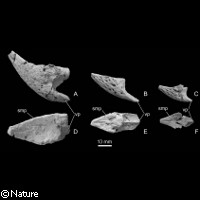Hungarian scientists discover island-hopping dinosaur
Archaeologists in Hungary have discovered the remains of a small-horned dinosaur that was previously thought to live only in North America and Asia. Members of the Hungarian Academy of Sciences (MTA) believe that the ceratopsian made its way to Hungary from Asia by island-hopping across the ancient Tethys Ocean to reach what now constitutes Europe. The find, presented in the journal Nature, is being heralded as highly significant and has prompted calls for a re-examination of the biogeography of that time. The fossils of the herbivore dinosaur, which is believed to have measured around 150 centimetres (cm) in length and weighed 25-30 kilograms (kg) and boasted a small horn and a mouth resembling a parrot-beak, were found last summer by MTA archaeologist Attila Osi in Iharkút in the Bakony mountains in western Hungary. Scientists have long assumed that ceratopsians, or horned dinosaurs, occupied only the North American and Asian sides of the supercontinent Laurasia, and not the Europe section in the middle. When the supercontinent split in the Late Cretaceous, palaeontologists assumed the fauna had split too - generally they have not found much overlap between the inhabitants of Europe and its former supercontinent brethren. However, Dr Osi's find seems to undermine this theory as he detailed last month in Nature in an article co-authored with Richard Butler, Humboldt Foundation Research Fellow at the Bayerische Staatssammlung für Paläontologie und Geologie (Bavarian State Collection for Palaeontology and Geology), in Germany, and David Weishampel from the Center for Functional Anatomy and Evolution at the Johns Hopkins University, US. They insisted that the remains of the newly found ceratopsian - named Ajkaceratops kozmai after Ajka, Dr Osi's hometown, and as a tribute to Hungarian geologist Karoly Kozma - rendered the idea that the creatures were geographically limited to Asia and western North America as 'overly simplified' and said the theory now 'requires reassessment'. The researchers pointed out that the discovery of the 85-million-year-old fossil 'unambiguously demonstrates that ceratopsians occupied Late Cretaceous Europe'. And added that 'when considered with the recent discovery of possible leptoceratopsid teeth from Sweden', the species 'may have reached Europe on at least two independent occasions'. The apparent discovery in 2006 of isolated leptoceratopsid teeth in the Kristianstad Basin, southern Sweden were heralded as representing the first record of horned dinosaurs from Europe. Dr Osi and colleagues believe that Ajkaceratops kozmai most probably made its way to Hungary from Asia by island hopping, crossing an archipelago that now represents Europe. 'The presence of a ceratopsian in the western Tethyan archipelago probably results from an early Late Cretaceous dispersal event from Asia, possibly by island-hopping across the Tethys Ocean,' the authors write. 'This dispersal would have been facilitated by subduction of the Tethys Ocean along the southern Asiatic margin with resultant insular island arches in this region. 'Ajkaceratops kozmai thus adds new complexity to our understanding of Late Cretaceous dinosaur faunas and demonstrates the need for re-evaluation of current biogeographical hypotheses.' MTA Chairman Jozsef Palinkas agreed that the findings called for a rethink about the migration routes and living areas of land-dwelling vertebrate of the Late Cretaceous. Dr Osi's name first grabbed the headlines 10 years ago, when he unearthed a small, intriguing looking piece of bone during a geological research session at Iharkút. It later turned out he was holding the first dinosaur fossil ever found in Hungary, according to the MTA.
Countries
Germany, Hungary, United States



